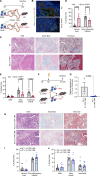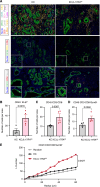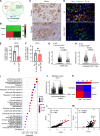Pancreatic Epithelial IL17/IL17RA Signaling Drives B7-H4 Expression to Promote Tumorigenesis
- PMID: 38842383
- PMCID: PMC11369627
- DOI: 10.1158/2326-6066.CIR-23-0527
Pancreatic Epithelial IL17/IL17RA Signaling Drives B7-H4 Expression to Promote Tumorigenesis
Abstract
IL17 is required for the initiation and progression of pancreatic cancer, particularly in the context of inflammation, as previously shown by genetic and pharmacological approaches. However, the cellular compartment and downstream molecular mediators of IL17-mediated pancreatic tumorigenesis have not been fully identified. This study examined the cellular compartment required by generating transgenic animals with IL17 receptor A (IL17RA), which was genetically deleted from either the pancreatic epithelial compartment or the hematopoietic compartment via generation of IL17RA-deficient (IL17-RA-/-) bone marrow chimeras, in the context of embryonically activated or inducible Kras. Deletion of IL17RA from the pancreatic epithelial compartment, but not from hematopoietic compartment, resulted in delayed initiation and progression of premalignant lesions and increased infiltration of CD8+ cytotoxic T cells to the tumor microenvironment. Absence of IL17RA in the pancreatic compartment affected transcriptional profiles of epithelial cells, modulating stemness, and immunological pathways. B7-H4, a known inhibitor of T-cell activation encoded by the gene Vtcn1, was the checkpoint molecule most upregulated via IL17 early during pancreatic tumorigenesis, and its genetic deletion delayed the development of pancreatic premalignant lesions and reduced immunosuppression. Thus, our data reveal that pancreatic epithelial IL17RA promotes pancreatic tumorigenesis by reprogramming the immune pancreatic landscape, which is partially orchestrated by regulation of B7-H4. Our findings provide the foundation of the mechanisms triggered by IL17 to mediate pancreatic tumorigenesis and reveal the avenues for early pancreatic cancer immune interception. See related Spotlight by Lee and Pasca di Magliano, p. 1130.
©2024 The Authors; Published by the American Association for Cancer Research.
Conflict of interest statement
J.K. Kolls reports grants from NHLBI and grants from NIAID during the conduct of the study. J.P. Allison reports other support from Achelois, other support from Adaptive Biotechnologies, other support from Apricity, other support from BioAlta, other support from BioNTech, other support from Candel Therapeutics, other support from Dragonfly, other support from Earli, other support from Enable Medicine, other support from Hummingbird, other support from ImaginAb, other support from Lava Therapeutics, other support from Lytix, other support from Marker, other support from PBM Capital, other support from Phenomic AI, other support from Polaris Pharma, other support from Time Bioventures, other support from Trained Therapeutix, other support from Two Bear Capital, and other support from Venn Biosciences during the conduct of the study; other support from Achelois, other support from Adaptive Biotechnologies, other support from Apricity, other support from BioAtla, other support from BioNTech, other support from Candel Therapeutics, other support from Dragonfly, other support from Earli, other support from Enable Medcine, other support from Hummingbird, other support from ImaginAb, other support from Lava Therapeutics, other support from Lytix, other support from Marker, other support from PBM Capital, other support from Phenomic AI, other support from Polaris Pharma, other support from Time Bioventures, other support from Trained Therapeutix, other support from Two Bear Captial, and other support from Venn Biosciences outside the submitted work. G. Lozano reports grants from The University of Texas MDACC during the conduct of the study. F. McAllister reports personal fees from Neologics Bio outside the submitted work. No disclosures were reported by the other authors.
Figures





References
MeSH terms
Substances
Grants and funding
LinkOut - more resources
Full Text Sources
Medical
Molecular Biology Databases
Research Materials
Miscellaneous

